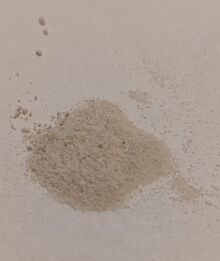Chemistry:Sodium deuteroxide
From HandWiki

| |
| Names | |
|---|---|
| IUPAC name
Sodium deuteroxide
| |
Other names
| |
| Identifiers | |
3D model (JSmol)
|
|
| ChemSpider | |
| EC Number |
|
PubChem CID
|
|
| |
| |
| Properties | |
| NaOD | |
| Molar mass | 41.003 g/mol |
| Appearance | White solid |
| Soluble | |
| Hazards | |
| GHS pictograms | 
|
| GHS Signal word | Danger |
| H290, H314 | |
| P260, P264, P280, P301+330+331, P303+361+353, P304+340, P305+351+338, P310, P321, P363, P405, P501 | |
| NFPA 704 (fire diamond) | |
| Related compounds | |
Related compounds
|
Sodium hydroxide |
Except where otherwise noted, data are given for materials in their standard state (at 25 °C [77 °F], 100 kPa). | |
| Infobox references | |
Sodium deuteroxide or deuterated sodium hydroxide is a chemical compound with the formula NaOD. It is a white solid very similar to sodium hydroxide, of which it is an isotopologue. It is used as a strong base and deuterium source in the production of other deuterated compounds. For example, reaction with chloral hydrate gives deuterated chloroform,[2] and reaction with n-nitrosodimethylamine gives the deuterated analog of that compound.[3]Template:Full reference needed
References
- ↑ "Sodium deuteroxide". https://www.sigmaaldrich.com/catalog/product/aldrich/372072?lang=en®ion=US.
- ↑ Breuer, F. W. (1935). "Chloroform-d (Deuteriochloroform)". Journal of the American Chemical Society 57 (11): 2236–2237. doi:10.1021/ja01314a058.
- ↑ National Cancer Institute (U.S.) (1973) (in English). Journal (51 ed.). the University of Michigan.
 |


